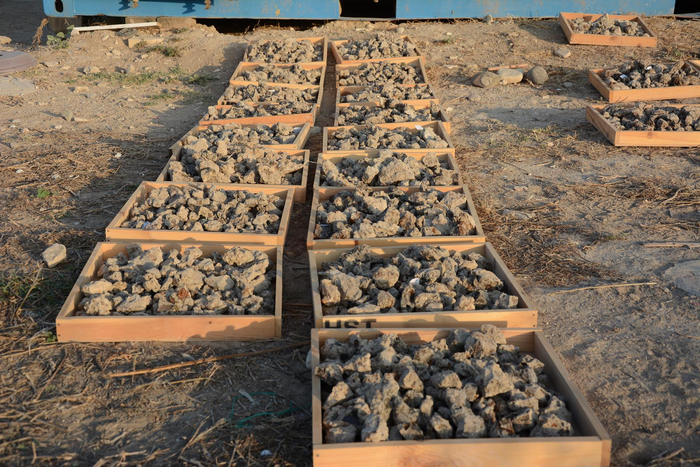Cyprus’s copper deposits created one of the most important trade hubs in the Bronze Age in the village of Hala Sultan Tekke
The coveted metal copper and a sheltered location turned the Cypriot village of Hala Sultan Tekke into one of the most important trade hubs of the Late Bronze Age. This has been shown by excavations led by researchers from the University of Gothenburg. Their study published in the Journal of Archaeological Science confirms the importance of the Bronze Age city in the first period of international trade in the Mediterranean.

Large quantities of imported goods
The central location of Cyprus in the eastern Mediterranean and a well-protected harbour created very favourable conditions for lively trade in Hala Sultan Tekke. Large quantities of imported goods in the form of pottery, jewellery and other luxury goods from neighbouring regions such as modern-day Greece, Türkiye, the Middle East and Egypt, as well as longer-distance imports from Sardinia, the Baltic Sea region, Afghanistan and India have been found. These finds show that the city was one of the largest trade hubs in the period 1500–1150 BC and was of great importance during the initial period of international trade in the area.
In addition to copper, highly sought-after purple-dyed textiles were also produced. The dye came from purple dye murex species from which the mucus that produced the purple dye was extracted. The city also produced and exported pottery with characteristic painted motifs of humans, animals and plants. The researchers refer to the artist behind these painted motifs as the ‘Hala Sultan Tekke painter’.
“The great thing about the many pottery finds is that we can assist our colleagues around the Mediterranean and beyond. No pottery has the same spread as the coveted Cypriot pottery during this period. By finding locally made pottery that we can date in the same layer as other imported pottery that was previously difficult to date, we can synchronise these and help colleagues date their finds,” says Peter Fischer.

Trade flourished for 500 years in Hala Sultan Tekke
The name of the Bronze Age city comes from the expedition having initially named the site after the mosque, Hala Sultan Tekke, which now stands close to the excavation site. Trade flourished in the city for almost 500 years, but like several other sophisticated Bronze Age civilisations around the Mediterranean, Hala Sultan Tekke collapsed just after 1200 BC. The prevailing hypothesis was that the ‘Sea Peoples’ invaded the eastern Mediterranean around this time, destroying its cities and bringing the Bronze Age civilisations to an end.
“In the past, it was thought that the ‘Sea Peoples’ were the sole explanation. Our research in recent years has given more nuance to this explanation. For example, there are now new interpretations of written sources from this period in Anatolia (modern-day Türkiye), Syria and Egypt, which tell of epidemics, famine, revolutions and acts of war by invading peoples. In addition, our investigations indicate that a deterioration in the climate was a contributing factor. All of this may have had a domino effect, that people in search of better living conditions moved from the central Mediterranean towards the south-east, thus coming into conflict with the cultures in modern-day Greece, on Cyprus and in Egypt,” concludes Peter Fischer.
The study entitled Interregional trade at Hala Sultan Tekke, Cyprus: Analysis and chronology of imports is published in the Journal of Archaeological Science: https://www.sciencedirect.com/science/article/pii/S2352409X22003856
- Black burnished bowls and bronze tools from Sardinia.
- A large bronze fibula (buckle/brooch) from northern Italy.
- Painted pottery from the Mycenaean and Minoan cultural spheres (modern-day Greece)
- Gold jewellery, figurines and vessels of faïence (glazed earthenware), scarabs and ivory objects from Egypt. Some of the scarabs show signets (seals) of various Pharaohs from the 18th and 19th dynasties of Egypt including Thutmose III, Horemheb, Akhenaten and his consort Nefertiti, but also from the later reigns of Ramesses I and Ramesses II.
- Silver jewellery, a silver figurine of a god and pottery from Anatolia (modern-day Türkiye).
- Tableware and large wine amphora from the Levant (Syria, Lebanon, Jordan, Israel and Palestine).
- Signet (seal) from Mesopotamia (Iraq).
- Red semi-precious gemstone Carnelian from India.
- Blue semi-precious gemstone Lapis Lazuli from Afghanistan.
- Blue-green semi-precious gemstone Turquoise from the Sinai Peninsula in Egypt.
- Amber objects from the Baltic Sea.
Press release from the University of Gothenburg, text by Jessica Oscarsson.


